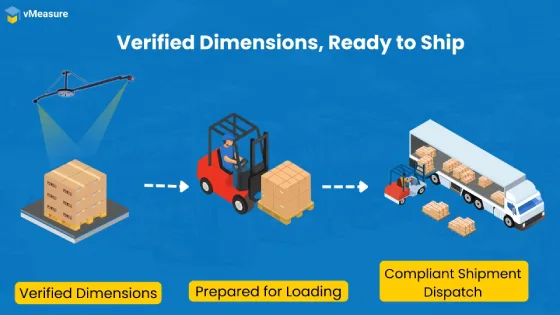A shipment can leave your dock in perfect NMFC compliance and still return to you on the carrier invoice as a costly reclassification.
Why do NMFC classification errors often start with early measurements?
- Rewrap for stability can add height or cause overhang.
- Consolidation of partial pallets can increase cube and weight.
- Cross-dock transfers can break down and rebuild pallets mid-route.
- Multi-carrier staging can shift freight to a different zone, where it may be reconfigured to optimize space.
What is the “Last Responsible Moment” for measuring freight?
- After all consolidation or rewrap is complete.
- When freight is staged in the correct carrier lane.
- Immediately before the trailer is closed out.

How does the final scan reduce freight reclass disputes?
- Capture – Automated pallet dimensioning systems like vMeasure record length, width, height, and weight in seconds.
- Store – The record is tied to the shipment ID in your WMS/TMS.
- Sync – Data flows instantly to the booking and bill of lading.
- Match – Carrier receives the same specs you have, eliminating mismatches caused by mid-process changes.
With automated pallet dimensioning systems like vMeasure at the dock or staging area, this scan takes seconds. The system captures L, W, H, and weight in one pass, attaches a time stamp and high-resolution image, and syncs it to your WMS/TMS instantly. That means your booking data and the carrier’s view are aligned in real time, greatly reducing the chance of a billing surprise later.
Which shipping scenarios benefit most from the last scan?
- Late-stage consolidation – Two partially palletized freight combined at the last minute can shift density. Without a rescan, your booking data is outdated before the trailer door closes.
- Multi-carrier outbound – Each carrier has different NMFC class sensitivities. A final scan ensures routing decisions are made on the correct dimensions.
- Cross-dock transfers – Freight rebuilt mid-route must be rescanned before it moves on to the next carrier or leg to avoid freight class mismatches.
How does integrating the final scan into your systems prevent errors?
A final scan is only as useful as what you do with it. When automated pallet dimensioners are integrated into your WMS/TMS workflow, the data is actionable, not just archived.
When API connections push measurements straight into your TMS or WMS and trigger corrective actions before pickup, there’s no manual re-entry and no delay, which means corrections happen in time to make a difference.
Can the last scan improve more than just compliance?
- Packaging optimization – The last scan identifies underfilled pallets that could be rebuilt to improve cube utilization, reducing dimensional weight charges.
- Load planning – Accurate final specs allow for better trailer fill, which can reduce the number of trips or pickups.
- Dispute resolution speed – With carrier-grade proof from minutes before pickup, most disputes can be closed in hours instead of days.
Since the automated pallet dimensioning system logs every scan with carrier-grade precision, you can build a historical data set for packaging optimization and load planning. Over time, this gives you the visibility to fine-tune pallet builds and trailer utilization without guesswork.
What KPIs show that the last scan is working?
- Measurement variance rate – Track the percentage of shipments where your recorded dimensions match the carrier’s numbers exactly. A lower variance means fewer adjustments and smoother billing.
- Pre-pickup corrections – Count how many pallets were re-labeled, re-packed, or re-routed before loading because the final scan identified a discrepancy.
- Dispute resolution time – Measure how quickly billing disputes are resolved once you have carrier-grade proof from the last scan.
- Post-pickup reclass rate – Monitor how often shipments are reclassified after leaving your dock.
- Dock throughput – Compare the number of pallets scanned per hour against your pre-implementation baseline.
Why should shippers make the last scan a standard step?
- Lock in the accurate measurement of your freight.
- Ensure your declared class matches what the carrier bills.
- Equip your team with carrier-grade proof to close disputes fast.
It’s a small change in process that delivers a big return. And in a year where NMFC compliance changes are tighter than ever, it’s a competitive advantage no shipper can afford to overlook.